Brian Clegg's Blog, page 63
November 17, 2015
The seat of evil
 An office chair, todayMany years ago, when I worked for a large airline with the initials BA, I had a back problem, which due to some problems pinning down exactly where the physical sensations were coming from led to a fairly unpleasant time. (Suffice to say that it was only diagnosed as a back problem after I had been asked to attend an STD clinic.)
An office chair, todayMany years ago, when I worked for a large airline with the initials BA, I had a back problem, which due to some problems pinning down exactly where the physical sensations were coming from led to a fairly unpleasant time. (Suffice to say that it was only diagnosed as a back problem after I had been asked to attend an STD clinic.)With some excellent exercises from a physiotherapist, the most embarrassing of which appears in my murder mystery novel A Lonely Height (great Christmas gift - shameless plug), the back pains came under control, and disappeared altogether many years ago.
Now the pains are back, if you'll pardon the circular expression. And I think I know why.
Ever since I started working for myself I've had a good quality office chair (I think I'm on my third now) with effective lumbar support. Even though I can often spend most of my working day at the computer - with frequent breaks, of course - I never have back problems. However, since September I have been rolling up to the University of Bristol two days a week to perform my duties as an RLF Fellow. And the office chairs, as illustrated, lack any back support.
I ought to stress I'm not picking out the University of Bristol for criticism here. I think this is still typical of many office chairs. But it is just surprising how a mere two days a week on one of these contraptions can bring it all back. Thankfully I haven't forgotten the exercises, and they have helped a lot already. But if you are a desk worker who suffers from back problems, do see if your chair could be the cause. You don't, in my experience, need one of those fancy kneeling chair thingies. Just a bit of decent back support can make all the difference.
Published on November 17, 2015 01:36
November 16, 2015
Tearing of hair - the sequel
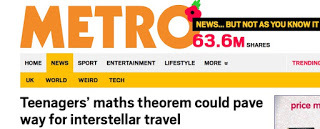 Not long ago I reported on a piece in the Metro paper claiming that a 'maths theorem could pave the way for installer travel.'
Not long ago I reported on a piece in the Metro paper claiming that a 'maths theorem could pave the way for installer travel.'I was delighted to receive an email from one of the paper's young authors, Ivan Zelich, pointing out that the media had distorted his message.
The Metro carried a quote from Zelich that read 'The theorem will contribute to our understanding of intergalactic travel because string theory predicts existence shortcuts in space, or so-called "wormholes" to cut through space.' However, I'm told that this 'quote' was never said. Zelich pointed out 'I actually meant the following, and you will understand how it could be misinterpreted':
The main lemma we developed to prove our theorem was highly projective in nature, which indicates to us that it could be generalised to possible more complex structures in high dimensional projective spaces. Since we are talking about applications, I would like to find a way, after such generalisation, to link this in order to understand the structure manifolds better and perhaps ultimately find something new to help aid (super-)string theory.
Why does this help with intergallactic travel?
It doesn't really show us a link with it, but of course solutions to one of Einstein's equations is a bridge, called wormholes if you will.
And with planetary travel, structures etc... the Fermat point is the minimal possible sum of the distances from the vertices of a triangle, and this has been generalised to polygons, so I said there may be connections there.This is certainly very different from the story as reported, though I was confused how wormholes came into it at all, as the Einstein-Rosen bridge came from a paper in the 1930s based on the general theory of relativity long before string theory was a glint in a physicist's eye. A further clarification from Zelich was to say that he did not mention intergalactic travel 'They asked me about it.' Which makes it puzzling as to why the media types thought of it. He then added, in danger of revisiting exaggeration 'What I meant to say was that if we understand the universe and this solution is true, then we have these short cuts in space. If the theorem is generalised it could have implications in algebraic geometry, and the leap I suggested was from isopivotal cubics to algebraic cubics in high projective spaces, which to my knowledge are important in the mathematics behind string theory.'
As I suggested in the original post, the main problem here is the way that the media exaggerates science stories to make them more eye catching. It shouldn't have been necessary. I would have been happy as a science journalist with 'Teenagers come up with theorem that could be pivotal in major physics theory,' even though my suspicion is that string theory is a dead end that will fade away over the next couple of decades.
However I do hope that the teenagers have also learned an important lesson - a lesson that working scientists and university PRs also need to learn - that it can be dangerous to give the media the tools with which to misinterpret you, because, given the opportunity, they surely will.
Published on November 16, 2015 01:36
November 13, 2015
Bonkers Dice World
 Mmmm! Dice World!I've just come across this short video that intercuts an interview I did on the book Dice World with a few remarks from one of my talks on it.
Mmmm! Dice World!I've just come across this short video that intercuts an interview I did on the book Dice World with a few remarks from one of my talks on it.The filmmaker seemed to take to heart the idea that Dice World is all about randomness by randomly inserting odd little asides. I can't decide if it's clever or just bonkers...
Published on November 13, 2015 04:52
November 11, 2015
Why I don't wear a white poppy
 I have the perfect upbringing to wear a white poppy today. My father was a Manchester Guardian reader who encouraged a healthy distrust of the establishment and had little time for the military. None of my friends or blood relations served in the armed forces - you have to go back to the First World War to find any relatives who did. Yet I always wear a red poppy.
I have the perfect upbringing to wear a white poppy today. My father was a Manchester Guardian reader who encouraged a healthy distrust of the establishment and had little time for the military. None of my friends or blood relations served in the armed forces - you have to go back to the First World War to find any relatives who did. Yet I always wear a red poppy.I understand where the supporters of the white poppy are coming from, and I absolutely support their right to wear it, but I think they miss the point. You can't re-write history, and it doesn't make sense to throw away the symbolism of the red poppy. If you are aware of its conceptual origins you know that it has nothing to do with triumphant militarism and everything to do with a tragic human sacrifice, even if that sacrifice has sometimes (if certainty not always) been justified.
If I am honest, I'd much rather the poppy, as a symbol of remembrance, were separated from the Royal British Legion, an organisation that certainly can slip into an over-emphasis on glorifying the military. A crass example of this is the folly of a Legion-produced photo of young children holding huge poppies with T-shirts saying things like 'Future Soldier'. Not to mention the saccharine and unsettling marching spectacle of their 'festival of remembrance'.
For me, though, the red poppy transcends its establishment associations and remains the symbol of so many ordinary men and women who gave so much for the rest of us, whatever the wisdom, or lack of it, exhibited by the generals and politicians. And because of this it remains for me the best symbol of remembrance.
Published on November 11, 2015 00:57
November 9, 2015
When physicists say many processes are independent of time, are they cheating?
 A lot of physicists like to say that time doesn't exist. This is, to be honest, showing off, and they don't really believe it. (If they insist they do, wait until dinner time and see how they react to not being fed because dinner time doesn't exist.) However they have a number of different arguments to support their claim, one of which is that many physical processes are totally reversible as far as time is concerned, showing no interest in the 'arrow of time.'
A lot of physicists like to say that time doesn't exist. This is, to be honest, showing off, and they don't really believe it. (If they insist they do, wait until dinner time and see how they react to not being fed because dinner time doesn't exist.) However they have a number of different arguments to support their claim, one of which is that many physical processes are totally reversible as far as time is concerned, showing no interest in the 'arrow of time.'A classic example of this is a pair of pool balls which head towards each other, collide and bounce off each other. They will point out that if you run a video of the event in reverse, it is indistinguishable from the video shown running forward. The direction of time is irrelevent. However, in making this assertion they are cheating, both subtly and in a very big way.
The subtle cheat is one that they will admit, but get around. You can point out that in traversing the pool table and in hitting each other, the balls will lose energy due to friction and the heat and sound generated in the collision. So the balls will be travelling slower after the collision than they are before. All you need do is measure the speed on the two journeys, and they video is no longer reversible.
True, say, the physicists. But for the purposes of the experiment we are assuming frictionless pool balls that lose no energy on collision. We understand that these don't really exist, but this is an acceptable simplification.
While you can argue whether or not this is truly acceptable, however, there is still the big cheat. It's what is called, in a different kind of experimental setup, cherry picking. Cherry picking is where you choose the results (consciously or unconsciously) that match your desired outcome. It can be a real problem in science, and one that good modern scientists are very strong on avoiding. However our (imaginary) physicists are cherry picking in the pool ball experiment too. Because they have selected only the frames of the movie that support their argument.
Pool balls do not, suddenly and for no reason, hurtle towards each other. Someone had to give them a push. So the full movie of the event should include that initial push. Show the entire movie backwards and it is very clear that the process is not symmetrical.
I ought to stress that there is still plenty of useful science that can be done by making this kind of cheat/simplification. But I also think that scientists have to be very careful to remember that this is what they are doing, and that in the real universe their models are supposed to represent, it is impossible to apply such a simplification. Otherwise it becomes very easy to confuse a model with reality.
Published on November 09, 2015 01:36
November 8, 2015
The Book of Magic - Review
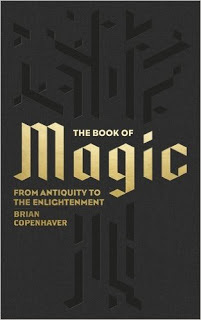 I have always been fascinated by magic, whether in its use in fiction or beliefs about magic. As I read more popular science than anything (and because I was sent a review copy) I had got it into my head that this was a book on the practice of and attitude to magic from a scientific, analytical viewpoint - looking at what was believed and why they believed it. However, the actual book was very different from this, and I suspect it will only appeal to a very narrow readership.
I have always been fascinated by magic, whether in its use in fiction or beliefs about magic. As I read more popular science than anything (and because I was sent a review copy) I had got it into my head that this was a book on the practice of and attitude to magic from a scientific, analytical viewpoint - looking at what was believed and why they believed it. However, the actual book was very different from this, and I suspect it will only appeal to a very narrow readership.What Brian Copenhaver does is to take a series of texts: biblical, medieval and renaissance (but no modern ones) that reference magic in some way and gives us a brief commentary on each (usually just one paragraph) before quoting the document at length. I am sure from a scholastic viewpoint this is useful and may even be important, but I really can't see why it is being published by Penguin in a manner that implies it is for a general readership, because it certainly isn't.
So unless you have the patience and the interest to read a whole string of obscure and verbose medieval documents, it probably shouldn't be on your to-read list.
If you are the kind of person for whom this should be on your to-read list, The Book of Magic is available from amazon.co.uk and amazon.com.
Published on November 08, 2015 05:54
November 6, 2015
Sound of tearing hair
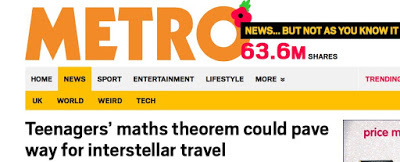 Not long ago I mentioned the evils of science exaggeration. It's all too easy for journalists, often aided and abetted by either university PRs or scientists themselves, to make over-the-top claims. I think I've just come across the most dramatic example of this I've ever seen.
Not long ago I mentioned the evils of science exaggeration. It's all too easy for journalists, often aided and abetted by either university PRs or scientists themselves, to make over-the-top claims. I think I've just come across the most dramatic example of this I've ever seen.'Teenagers' maths theorem could pave the way for interstellar travel,' screams the headline. No, it really, really couldn't. There's a lot to be said for that Metro masthead 'news... but not as you know it'. Though to be fair, they were by no means alone in making this claim.
The origin of this hysterical unlikelihood was a geometry paper by a pair of 17-year-olds. The fact that Xuming Liang and Ivan Zelich produced the paper, published in the International Journal of Geometry is certainly newsworthy. But the leap from Generalisations of the Properties of the Neuberg Cubic to the Euler Pencil of Isopivotal Cubics to Starfleet is considerable.
Here is the phrase that does all the damage. 'The theorem will contribute to our understanding of intergalactic travel because string theory predicts existence shortcuts in space, or so-called "wormholes" to cut through space.' The quote is from co-author Zelich. But the journalists involved don't seem to have given any thought to the possibility that a 17-year-old could be good at geometry without knowing too much about life, the universe and PR.
The first problem with that statement is that string theory doesn't predict wormholes. It doesn't predict anything - that's one of the problems with string theory. Nothing predicts wormholes actually exist, but general relativity does provide a potential mechanism for them with the proviso that they would be pretty well impossible to travel through. But even if string theory did predict wormholes, so what? String theory is not at this stage a useful scientific theory for anything, and may well end up being discarded. And even if it that weren't the case, a geometry theorem does not somehow turn string theory into an interstellar transport mechanism. To put it politely, it's baloney.
Perhaps slightly more with-it journalists than those on the Metro would have raised an eyebrow at Zelich's other quote 'It also helps finding minimal possible math between certain planets based on their structure,' which I've read ten times and still haven't a clue what it means.
So, thanks to the wonders of science exaggeration, what was a really good story - teens publish impressive original geometry paper - has become a truly naff example of non-science reporting. Nice.
Published on November 06, 2015 01:10
November 5, 2015
How Many Moons Does the Earth Have?
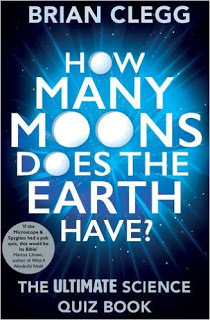 I can't remember when I was last as excited about a new book coming out as I am about
How Many Moons Does the Earth Have?
, my science quiz book, which is available from today. And to make it even better, it was great fun to write.
I can't remember when I was last as excited about a new book coming out as I am about
How Many Moons Does the Earth Have?
, my science quiz book, which is available from today. And to make it even better, it was great fun to write.One driver for this is that I enjoy pub quizzes, but I've always been disappointed with the quality and quantity of the science and technology questions. I think the thing that pushed me over the edge was taking part in a quiz which featured the question 'Who invented the gramophone?' According to the organisers, the answer was Thomas Edison, and despite my protests, they would not accept the correct answer. (It is, of course in the book.) So one thing this book does is provide two complete quizzes, each containing 6 traditional rounds with 8 questions each, plus two special rounds, one partly pictorial and the other with a sort of puzzle element, which can be used as table rounds. This means it can be run as a science quiz, or to provide science rounds to a general quiz.
However, realistically, 99% of readers are not going to run a quiz, so it's designed to be enjoyable to read through from end to end as well. Each of the 96 normal questions has the question, plus a few 'while you are thinking' factoids on one page and the answer, plus a page of explanation that expands on the answer, over the other side. And a reference to read more, if the topic grabs you. So you can test yourself, turn over and be surprised, then fascinated by what are inevitably the most weird, wonderful and unexpected answers I could find in all of science.
The other reason I'm delighted is that I think the publisher has done a great job with the book - the cover, which is textured, looks great, and it's priced to make it a really attractive stocking filler or just a 'Why not?' buy.
Okay, I'm biassed. But wouldn't you want to try out questions like these?
If the Earth were made into a black hole, what would be the diameter of its event horizon?What links the elephant Tusko at Oklahoma City Zoo and Timothy Leary?If you too one step each second in seven-league boots, what would your speed be in miles per hour?What was Einstein’s 1930 patent for?Why did Uuq become Fl?I think this does what QI does for TV in a book - but in a less 'Nah-nah, you're wrong!' fashion. Which is appropriate given the title question, where I disagree with every answer that QI has ever given on that topic.
It's available from amazon.co.uk and amazon.com. If you prefer other ebook formats, its on those too - take a look at its web page with full details.
Published on November 05, 2015 01:18
November 2, 2015
Is 5x3 the same as 3x5?
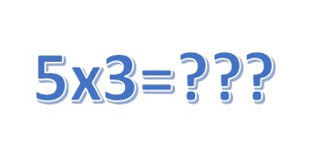 The Internet has gone mildly bonkers over a child in America who was marked down in a test because when asked to work out 5x3 by repeated addition he/she used 5+5+5 instead of 3+3+3+3+3.
The Internet has gone mildly bonkers over a child in America who was marked down in a test because when asked to work out 5x3 by repeated addition he/she used 5+5+5 instead of 3+3+3+3+3.Those who support the teacher say that 5x3 means 'five lots of 3' where the complainants say that 'times' is commutative (reversible) so the distinction is meaningless as 5x3 and 3x5 are indistinguishable.
It's certainly true that not all mathematical operations are commutative. I think we are all comfortable that 5-3 is not the same as 3-5.
However. This not true of multiplication (of numbers). And so if there is to be any distinction, it has to be in the use of English to interpret the 'x' sign.
Unfortunately, even here there is no logical way of coming up with a definitive answer. I suspect most primary school teachers would expands 'times' as 'lots of' as mentioned above. So we get 5 x 3 as '5 lots of 3'. Unfortunately that only works because they are using childish language. A secondary school teacher is more like to expand 'times' as 'multiplied by'. And so we get '5 multiplied by 3' - if you think about it, this clearly means 'take 5 and reproduce it three times.' So it means 5x5x5.
I think an excellent last word can be given to a Dr Petersen on the Math [sic] Forum: [Multiplication] is a commutative operation that can be modeled in two symmetrical ways as repeated addition (when applied to whole numbers).
Conclusion? The child was as correct to use this formulation as the one being taught, and the teacher was wrong to mark him/her down.
Published on November 02, 2015 02:08
October 27, 2015
Is your business card intelligent?
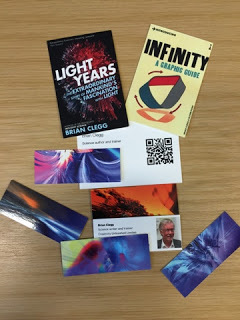 Some of my Moo cardsBusiness cards are generally boring necessities, and like many people I've tended in the past to get my cards from the cheapest possible supplier - they might not look beautiful, but they do the job. I confess, I still do this with my 'gig handout cards' which just give details of my website, Twitter address etc. so anyone who feels the urge to follow me up after a talk can do so. But for my 'proper' cards with full contact details, I've switched over to Moo*.
Some of my Moo cardsBusiness cards are generally boring necessities, and like many people I've tended in the past to get my cards from the cheapest possible supplier - they might not look beautiful, but they do the job. I confess, I still do this with my 'gig handout cards' which just give details of my website, Twitter address etc. so anyone who feels the urge to follow me up after a talk can do so. But for my 'proper' cards with full contact details, I've switched over to Moo*.This company has been recommended to me for ages by fellow writers, and having got some of their products, I can see why. They feel to be a truly quality product, and they have a number of innovations, including half height cards, cards with curved corners, square cards and cards with a different, full colour photo on the back of each. They also make it easy to incorporate useful features, like phone-scannable QR codes to jump straight to your website. In fact I loved them so much I got both half height and full-sized versions. There's no doubt they are relatively expensive, but I find I don't give out this kind of card very often, so it's not much of a luxury.
Now Moo has a new product: business cards with a built-in NFC chip, so you can use phones with the ability to pay-by-tap to pull up anything from contact details to go straight into your address book to that good old website link again. My feelings are a bit mixed about this. I applaud their innovation, but I'm not sure how useful they'll be as you are bound to discover that most of the people you give a card to don't have the hardware (and even if they do, might be reluctant to download any required software).
Even so, you have to admire the company for ensuring that it stays at the leading edge of businesscardery.
* As it is sometimes the case, I need to emphasise I am not being sponsored by Moo in any way to make this recommendation. However, if they would like to send me a voucher to get some more cards for free, I wouldn't complain.
Published on October 27, 2015 02:48



